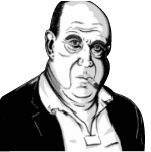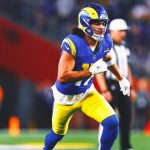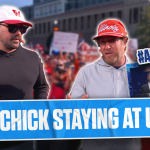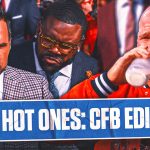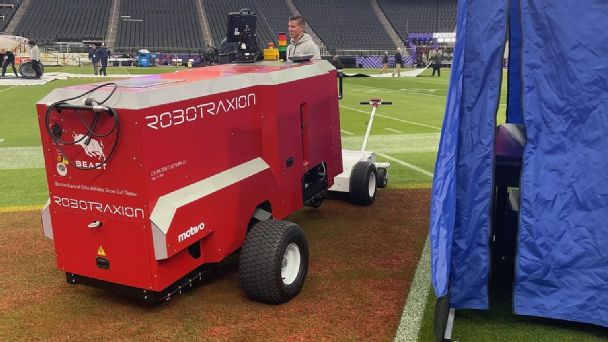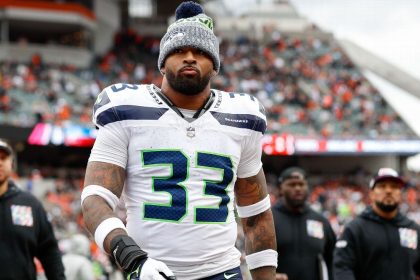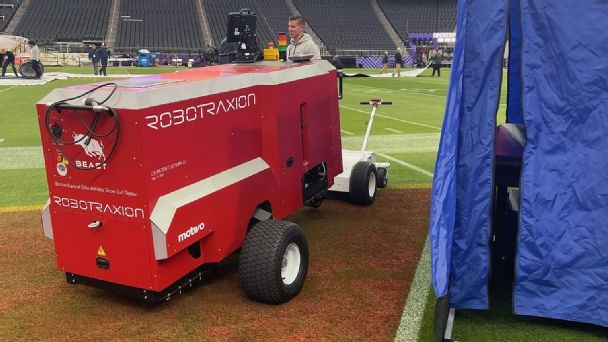
WHEN QUARTERBACK AARON Rodgers suffered a season-ending left Achilles injury on the first drive of his New York Jets career, the yearslong debate over playing surfaces began anew.
Before the severity of Rodgers’ injury had been confirmed, calls for natural grass fields rang out across the NFL. The grass vs. turf debate continued to take center stage throughout the 2023 season as star players suffered noncontact injuries.
MetLife Stadium, the site of Rodgers’ injury, had received so much criticism in the seasons leading up to his Jets debut that new turf had been installed before the 2023 offseason — to which Rodgers gave his approval.
Perhaps more than the surface composition itself, the lack of consistency from one field to the next is often the most frustrating aspect of the debate for players. The NFL acknowledges that, as of now, there are potentially too many different types of surfaces, both synthetic and natural grass.
“If you’re not going to mandate grass, then why aren’t all turf fields the exact same turf so guys get used to playing on the same turf everywhere?” San Francisco 49ers tight end George Kittle asked.
“Every field has a different turf, so it’s just like you’re playing on a different surface. NBA guys don’t play on different wood. Hockey guys don’t play on different ices all the time … So, I just wish we played on a surface that was similar week in and week out.”
While several studies have been published comparing injury rates on various synthetic versus grass surfaces, thus far there has not been a means of onsite testing of individual field surfaces through a biomechanical engineering lens.
Enter: the BEAST.
During the 2023 season, the NFL and NFLPA launched a pilot program involving a mobile machine that traveled to multiple stadiums to test various surfaces under a range of conditions, the first such testing ever done. Additionally, four stadiums — MetLife in New Jersey, Ford Field in Detroit, Mercedes-Benz in Atlanta and AT&T Stadium in Dallas — had a mobile unit housed at their facilities.
The aggregated 2023 data is being analyzed now. The NFL/NFLPA Engineering and Joint Field Surfaces Committees will meet to discuss early findings this offseason, and those parties will continue the dialogue as data collection continues. The plan is to formally present their analytics to the league and the players association after another year of data collection, sooner if there is a dramatic discovery worthy of immediate attention.
“If you had fewer, instead of 30 surfaces that all play differently, you had two, or three, or five surfaces … [Players] are going to know what their bodies, their joints and muscles, could expect when they’re participating on a surface,” said Jeff Miller, NFL executive vice president of communications, policy and health and safety. “And therefore they would probably be less unhappy moving from surface to surface.”
While local variations, including the environment, prohibit a single surface that will be suitable for all 30 NFL stadiums, the NFL and NFLPA hope the BEAST can provide recommended practices and better standardization across the league.
“We want to set the safety and performance goal,” said Dr. Kristy Arbogast, a member of the joint NFL/NFLPA Engineering Committee who has worked with the NFLPA on injury prevention topics for the last decade, “and then hold all fields, whatever they’re made of, to that target.”
THE BEAST (BIOMECHANICAL Elite Athlete Shoe-Turf Tester) was originally developed for the laboratory in 2008 by the NFL engineering consultants at Biocore. Using samples of synthetic surfaces from playing fields, scientists could study the properties of rotation and traction after impact — two forces an NFL athlete’s leg encounters — when the cleat contacts the ground and engages with the field surface.
“Traction is really the stickiness or slipperiness of the surface,” Arbogast said. “So if a player goes to cut or pivot as they start their route, as linemen try to dig in and withstand opposing linemen, having the field — and that interaction between their body and the surface — be steady and repeatable but not grab too much is really what traction means.”
By creating a cleat model based on the attributes of an average NFL player, scientists have been able to obtain valuable insights into the relationship between the cleat and the surface, but there were limitations to the lab setting. By only testing a small surface sample, it was not possible to truly extrapolate results to all areas of a playing field. The size of the first generation BEAST and the manpower required to operate it did not allow for onsite testing.
Enter the mobile BEAST. In 2020, Dr. Philipe Aldahir, a senior research engineer, joined the Biocore team to work on the second generation of the machine with the intent of bringing the lab to the field. By automating multiple operational elements under the housing of the unit, the newest version of the BEAST is both mobile and easier for an individual to operate. It can travel to multiple locations on the field, encompassing the area from one end zone to the other and from sideline to sideline.
The field, visually represented on the control panel, is divided into a 60-section grid. As data is collected during testing, it travels to the cloud where it can then be analyzed and converted to a visual display. The display immediately allows the viewer to see the entire representation of the field surface and how each section within the grid is performing.
Taking this data is one jumping off point but, as NFL Field Director Nick Pappas is quick to point out, players are ultimately the end users and their feedback is critical to the process of studying surface type and composition.
“We want to provide surfaces that perform best for our players,” Pappas said. “We want them to be able to go out and play and execute and be able to just focus on football.”
RETIRED NFL OFFENSIVE lineman Mark Schlereth, who endured more than two dozen surgeries during his playing career, recalled how tight and swollen his lower extremity joints — hips, knees, ankles and feet — would feel after playing on AstroTurf, the first synthetic field surface, often requiring extra treatment the subsequent week to recover in time for the next game.
Schlereth referenced one game in particular against the Detroit Lions in the Pontiac Silverdome, where the extra play in overtime left him “hardly able to walk until the following Thursday.”
He believes the “grippiness” or stickiness of that surface not only left players exceedingly sore, it also hindered performance.
“As an offensive lineman, you need to slide across the grass,” Schlereth said. “The biggest issue became which shoes to wear each week depending on which stadium we were playing in.”
He said players would keep multiple pairs of “travel” turf shoes with a pair customized specifically to match to each field surface. The customization consisted of grinding their cleats down to the nubs so they wouldn’t stick.
While the most recent injury data from the 2023 season shows a negligible difference in injury rate on grass vs. synthetic turf, players often still report feeling worse when playing on a synthetic surface.
In October, Kittle expressed his dissatisfaction with the field surface at US Bank Stadium after banging his knee and hobbling off the field during their game against the Minnesota Vikings.
“It’s very springy but it’s basically cement,” Kittle said. “When you slam on it, it really stinks.”
There are differences between all surface types — including natural grass — that may result in a different player experience from one week to the next. Elements such as pile height, stitch gauge and infill composition for synthetic surfaces and grass type, light conditions and drainage requirements for natural surfaces are but a few of the variables that can contribute to differences in how a field ultimately presents itself to a player.
And conditions are not stagnant across the season.
Weather, field maintenance and stadium use for non-NFL events can alter surfaces and change the feel for playing football dramatically.
Miller said the pilot study with the BEAST, at the recommendation of the NFLPA, included athlete surveys taken after every game in 2023.
“When we go back and measure the surfaces with the tools that we have, we want to see if we can correlate these feelings with some objective metrics … In the same way that we want to correlate injuries with some objective metrics from the tools we use to measure them,” Miller said.
TO DATE, THERE is no data establishing a relationship between how a playing surface feels to NFL players and the injury risk associated with that particular surface. It doesn’t mean there is zero impact; it merely indicates there is yet another data-driven question that remains unanswered.
As the Minnesota Vikings prepared to replace their slit-film synthetic turf this offseason — the Cincinnati Bengals also recently announced they will do the same — the Vikings paired their health and safety leaders with their field management and operations leaders to guide the process. According to Tyler Williams, Vikings vice president of player health and performance, the group sought out the most recent available science from Biocore, conferred with NFL/NFLPA engineers and interviewed turf experts and vendors in an effort to use the latest research to fuel their decision-making.
“We tried to pair what the science says with clinical application to get the safest surface with the best performance results for our players,” Williams said.
But that wasn’t all.
Beyond the science, the Vikings wanted their players to be comfortable with the final turf selection. Members of the players’ leadership council weighed in on features that were important to players and that subjective expertise was included as they consolidated their options.
The Vikings ultimately settled on a single monofilament field with 2½ -inch pile height manufactured by ActGlobal.
“The goal was to get a turf that plays as close to natural grass as possible,” Williams said.
Last season was the first year of data-collection in what is intended to be a multi-year study. The plan for next season is to incorporate testing on all natural grass surfaces while simultaneously increasing the frequency of testing at all NFL stadiums. The new surfaces for the Vikings and Bengals will add comparison data to the mix.
As more of the BEAST units are built, more will be permanently established in various club locations to permit in-season monitoring of surface conditions. The plan includes eventually testing international field surfaces, as well.
The NFL, with support from the NFLPA, also launched a HealthTECH Challenge. It’s a crowd-sourced invitation for submissions “to accelerate innovations that can help make playing surfaces more consistent and safer for players.” Earlier crowdsourcing initiatives related to health and safety, such as helmet innovations, have yielded success stories, so the prospect of getting ideas and insights from inside and outside the turf science world is appealing. Entries have been submitted and the winner or winners will be announced in late May.
While there are more questions than answers at this stage when it comes to ideal playing surfaces, there is confidence science will ultimately lead all parties to common ground.
It may not happen all at once.
“We’ll have insights along the way that can provide incremental steps, ” Miller said. “And over time, not necessarily one year but over a series of years, we’re going to get to a much better experience for the players when it comes to performance, as well as injury, as well as the ability for any club to be able to understand what it is that they’re providing.”
ESPN San Francisco 49ers reporter Nick Wagoner contributed to this report.
